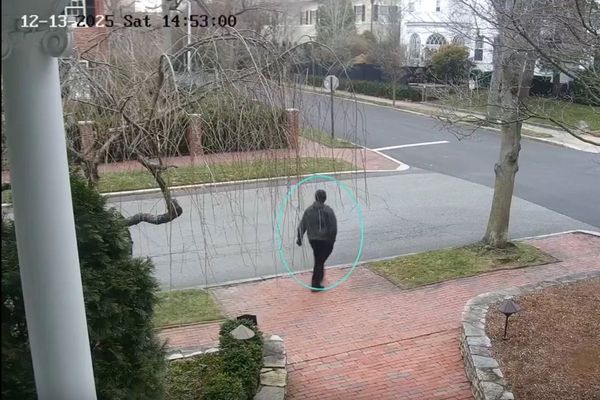
When Luca Guadagnino began thinking about posters for his latest film Queer, in which Daniel Craig plays an American expat picking up men in Mexico City, one artist immediately sprang to mind. The director had been following Jake Grewal for several years, quite taken with his intensely personal romanticism. Grewal, in turn, had been quite taken with Guadagnino’s Call Me By Your Name. So it was a meeting of minds. “I showed Luca this painting,” says Grewal, gesturing to a beautiful canvas depicting two embracing figures. “And he said, ‘That’s amazing. It’s basically my film!’”
Grewal’s ghostly sketch now features on special edition posters for Queer, ostensibly portraying the film’s main protagonists, Craig and Drew Starkey, in a moment of closeness, of even merging into one – perhaps after they’ve taken ayahuasca, the film being loosely based on William S Burroughs’ 1985 novella of the same name. The director rightly identified such intimacies as a constant theme of Grewal’s work, in which feelings of absence and longing infiltrate his depictions of naked male figures, lost in nature or at one with it.
On a freezing winter’s day, I meet Grewal at his London studio ahead of Under the Same Sky, his upcoming show a few miles away at Studio Voltaire. Despite the cold, he is pure warmth, with his paint-splattered black hoodie and taupe-coloured clogs, silver piercings in each ear and big confiding eyes. Within 10 minutes, he’s told me about the relationship he started after an exhibition in Chichester last year.
“The end of a show is like an emptiness,” explains the artist. “It’s quite beautiful to fall into a relationship after something so intense. That relationship has ended, which is why I’m quite confused that my new paintings continue to be so bright. But I’m kind of accessing memories and still feeling fond of that time.” Grewal, it’s clear, thrives on feeling.
The Studio Voltaire exhibition centres around a monumental painting, The Ceaseless Cycle of Erosion, which is currently filling the biggest wall of Grewal’s studio. It’s 2 metres tall and nearly 6 wide. By the time of the show, its three canvases will have been re-stretched on to a curved frame, the unclothed figures it vividly portrays seeming to invite you on to their rocky shoreline. “Last year,” says Grewal, “I was in Portugal learning to surf, taking pictures. In queer representation, there is often this motif of figures on rocks, adventuring, clambering or kind of lounging. It’s an other space which – like trees – possesses a kind of mystery, even though it’s quite exposed.”
Grewal lists the many things that crossed his mind as he put together this and other work for the new show: a nudist beach, prelapsarian but also sexualised; the notion of water as a great vantage point but also a lonely space; how bathing is seen as leisurely but can also be dangerous. “Maybe the tide will come in and the rocks will disappear,” he says. “Then maybe you’re stuck.”
At 30, Grewal is a fast-rising star of British art, one who manages to seem fundamentally of his time yet keenly aware of the old masters. His work sits in some of the UK’s most prized public collections, including that of Hepworth Wakefield, which recently bought his 2022 charcoal drawing, The Sentimentality of Nature.
Grewal grew up in the Kennington area of London. As a child, he was constantly drawing, while also showing great promise as watercolourist. He came to the fore in the 2020 New Contemporaries graduate show with three paintings: The Familiar Whisper of a Path Now Silent, which depicts a boy sitting in a tree, looking directly out from a spot abounding with light and foliage; and Vibrating Rims//Seeking Hands I and II, two intimate scenes of a couple embracing in the shadows.
The bold nature of these works – some have commented on their frank configuration and their “difficult brown-ish” palette – belies the challenging environment in which Grewal came to embrace painting. At Brighton’s School of Art, he says, the emphasis was on satire and conceptual justification: people doing bad paintings to make fun of the whole idea. His work, by contrast, was figurative and heavy on metaphor, hinging on the expressive, the poetic, the dreamlike. “I might be too earnest,” he says. “There are different ways of making things and some are never going to be me. I’d much rather look at something that’s going to make me cry than laugh, especially in painting.”
After graduating, he worked as a cleaner, listening to homoerotic audiobooks while trying to keep his studio practice afloat. Then he did an MA at the Royal Drawing School in London – and everything changed. He is keen to namecheck one tutor, Sarah Pickstone, for encouraging him to push his honesty to the limit. “There was this energy that built up within me,” he says. “It demanded I take the clothes off the figures. There was still a lot of metaphor and symbolism, but now the figures were naked and in nature. From there, I got looser and looser.”
He spent a month at Rhode Island School of Design, on a scholarship led by Gwen Strahle, who would talk to him about JMW Turner, Frank Auerbach and Leon Kossoff – artists who were fundamental to Grewal, yet unknown to his many of his peers. It felt like validation. He also discovered compressed charcoal and has not stopped using it since.
During Covid, since museums were closed, Grewal tracked down National Gallery catalogues on eBay and used the works they contained as drawing inspiration. He dived into queer cinema, became obsessed with Degas. “I really poured my heart into my practice,” he says. “I was drenched in it.”
His studio is everything you could want an artist’s studio to be. Paint pots and spills are everywhere. Books line the window sills and shelves, all within easy reach. When a British Museum curator recently discovered Grewal’s charcoal drawings, she directed him to Georges Seurat. “Before Seurat gets to pointillism, he does this dissolving thing,” says Grewal, opening a nearby book to show me. When I mention Eadweard Muybridge’s studies of movement, he replies “Exactly!” and reaches for book about them.
“I have all these clipboards,” he says, lifting one up bearing a fragment of a landscape photograph, ready to be consulted while painting. “I think this is how Jenny Saville works. Like, I want to paint this place which is somewhere I haven’t been, but which reminds me of Cornwall. And I want to paint it like Monet, in terms of a shimmery effect. I don’t know how successful that will be but …”
For all his love of charcoal, the Studio Voltaire exhibition will feature only paintings on canvas. The refreshed palette – the brilliant azures, yellows and pinks, not to mention the outsized dimensions of that central piece – will surprise fans as much as they have surprised the artist himself.
“My paintings often reflect an emotional state,” he says. “They’re an expression of a history, or a memory – a kind of figuring out. In the past, the dark layers have been directly confusing. They’ve been about hiding things. Those qualities are probably going to be in these new paintings now, but they’re also bathed in this light, which I’m surprised about.” He ascribes this – and a “weird confidence” – to time spent sketching around St Ives in Cornwall, as well as to a recent and wide-ranging trip to India, his first to the country his father comes from.
Grewal is often described as a queer figurative painter, with his south Asian heritage frequently added to the mix. None of these are labels he particularly covets. “I’m queer and I’m a figurative painter,” he says. “I don’t really know what else to say. It’s almost like I’m being asked to label myself before I’ve made those personal discoveries myself. I haven’t referenced being south Asian in a formal way in an exhibition – because that’s not yet my experience.”
For a long time, it felt important that people knew that he was from London. However, he has begun to wonder if the unspecified locations in his paintings are his way of grappling with feelings of displacement. “That is something that I’m processing,” he says. “It’s lovely having people write about your work – but it’s a funny thing when you’re still trying to figure out why you make it.”
He goes on: “In queer figuration, there’s a desire for people to think of adolescence, of nymphs, of idealised youth. There’s a yearning for unattainable beauty, or purity, that a lot of older gay men have. There is nostalgia in my work, but there’s also a darkness and a vulnerability. I’m trying to be as honest and as real as possible.”
• Jake Grewal: Under the Same Sky is at Studio Voltaire, London, from 15 January until 13 April







